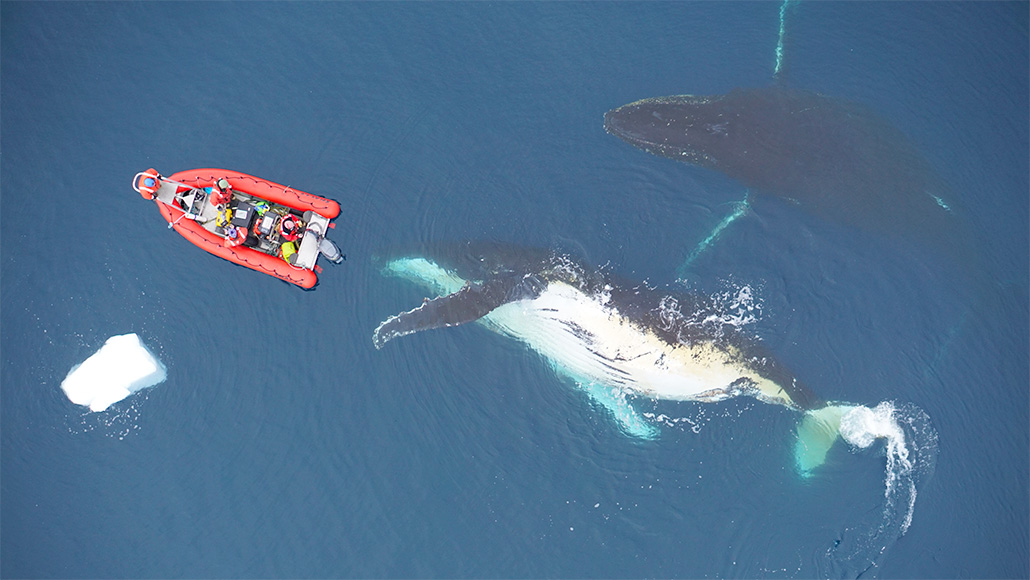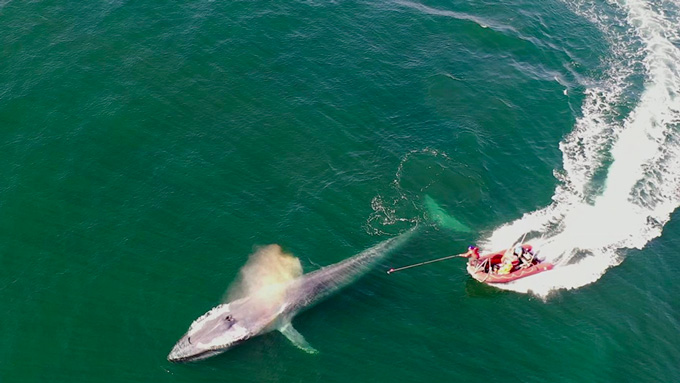
In a new study of foraging behaviors and body size, scientists attached sensors to more than 100 individual cetaceans (two humpback whales off Antarctica in 2018, shown) and tracked them over a decade.
Goldbogen Lab./Stanford Univ., Duke Univ. Marine Robotics and Remote Sensing. Photo taken under permit ACA/NMFS #14809
- More than 2 years ago
Read another version of this article at Science News Explores
Sophisticated sensors suction-cupped onto the backs of whales are helping biologists answer two long-standing questions: Why are whales so big? And why aren’t they bigger?
Being big in general boosts whales’ ability to reach more food for less effort, helping them exploit the riches of the deep sea that are beyond the reach of many other creatures. By estimating the energy used — and gained — when foraging for 13 species of whales and porpoises, scientists have shown that how big the creatures get is influenced by feeding strategy and prey availability.
The sizes of toothed whales like orcas, which use echolocation to hunt for individual prey, appear to be constrained by how much food they can grab during a dive, researchers report. That’s not the case, however, for blue whales and other filter feeders, which tend to be much larger than their toothed cousins. Filter feeders alive today aren’t constrained by food availability, which may mean they might be limited by their biology. Or the animals could be on their way to evolving to be even bigger, according to a study in the Dec. 13 Science.
“This is a fascinating study,” says Samantha Price, an evolutionary biologist at Clemson University in South Carolina who wasn’t involved in the research. Biologists have been thinking about the evolution of bigness for a long time, she says, “but this paper, through incredible effort, actually got some data about these hard-to-study behaviors.”
In the last 5 million years, whales have become larger than ever before, and the blue whale grew into the largest known creature in the history of life, says Jeremy Goldbogen, a comparative physiologist at Stanford University. Changes in glacial cycles, wind and ocean currents, he says, have intensified upwellings of nutrients in special pockets of the ocean, creating sparse, but absurdly dense patches of tiny crustaceans and fish and other animals — whale food.
Being large has helped whales exploit these food bonanzas in a few ways. Bigger creatures can travel farther using less energy per unit of mass, helping whales cross wide swaths of barren ocean to reach upwellings. Larger bodies also support larger lungs, buying bigger whales more time to feed during dives.
Simply put, bigger whales were thought to be more efficient at finding food, Goldbogen says. But without a detailed accounting of energy gained from food versus energy expended from diving and hunting, this idea had remained mostly speculative, he says. “We just didn’t know much about what these animals were actually doing underwater.”
So Goldbogen and a team of international researchers enlisted the help of technology-packed sensors, temporarily affixed via suction cup to the backs of more than 100 individuals from 13 species of cetaceans. Over a decade, the team tracked more than 10,000 feeding events of creatures as small as 50-kilogram harbor porpoises to 150,000-kilogram blue whales. “It was no small task,” Goldbogen says.

The tags, which housed pressure sensors, accelerometers, hydrophones and cameras, relayed a daily diary for the whales. The researchers could tell when filter-feeding giants opened their mouths to lunge at swarms of krill, or when sperm whales echolocated an octopus. All together, these data allowed the researchers to estimate how much energy different types of whales expend per dive.
Those tags were combined with sonar readings of prey density, as well as stomach dissections of stranded whales, to paint a detailed picture of different whale diets. That allowed the researchers to calculate an energy budget for each species. In other words, the team could estimate how much of a caloric bang a whale gets for its exertion buck, revealing the relationship between foraging efficiency and size.
Toothed whales, like the titular sperm whale of Moby Dick, use echolocation to hunt for individual prey, usually squid or octopus (SN: 8/5/16). The researchers found that being big helps these creatures dive deeper and access these higher-calorie prey. But after a point, these whales’ foraging efficiency wanes with increased size. While every once in a while, they might find a giant squid — a big energy payoff — there just isn’t enough such prey in the ocean for the whales to get any bigger, given the energy needed to dive and hunt, Goldbogen says.
In contrast, bulk filter feeders, which target dense aggregations of tiny krill and other crustaceans, only get more efficient with size. The whales get a huge infusion of calories — calculations suggest more than 10 million calories, Goldbogen says — from a single gulp, which takes comparatively less effort than chasing down a squid. Rather than being limited by a lack of prey, blue whales and other filter-feeding whales may instead be limited by their biology, though the study wasn’t designed to determine what that physical limit might be. It may not be possible physically to engulf more krill than the animals currently do.
Alternatively, the size of these ocean giants might not be limited at all. The creatures could be on their evolutionary way to becoming even bigger, as long as populations of krill stay abundant. “Perhaps, millions of years from now, we’ll see even bigger ocean giants,” Goldbogen says.






